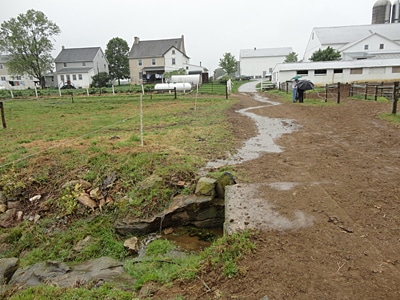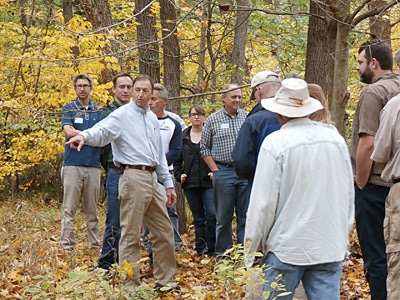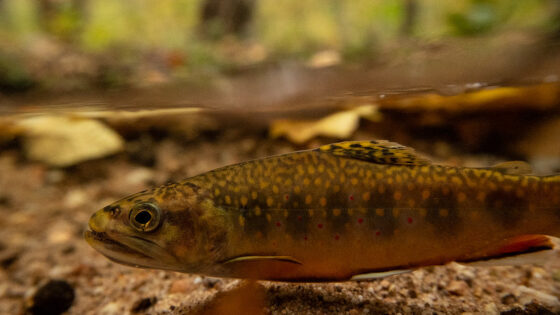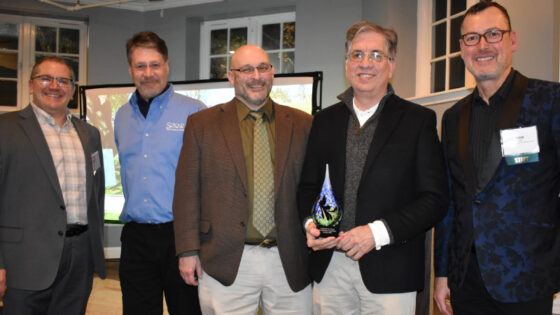In between the flurry of watershed restoration planning and fieldwork, our Watershed Restoration team was busy working with watershed planning professionals, leading workshops in partnership with the USDA’s National Resource and Conservation Service program and the Smithsonian Conservation Biology Institute, hosting workshops here in Avondale, Pa., presenting recent developments in Cumberland, Md., and speaking at conferences and annual meetings in Maryland and Pennsylvania.
Wilkes-Barre and Rock Springs, Pennsylvania

In August, more than 40 watershed planning professionals attended a Penn State Extension Service-hosted training in Wilkes-Barre, where David Wise, Stroud’s Restoration Program Manager, discussed the ecology of forest buffers and strategies for maintaining reforested sites.
Also in August, Bern Sweeney, Ph.D., Stroud Center Director, attended a Penn Ag industries Association meeting to share “Research, Education, and Restoration Programs of the Stroud Water Research Center” with meeting attendees.
New York and Virginia
In September, Sweeney and Matt Ehrhart, Stroud Center Director of Restoration, traveled to Big Flats and Cortland N.Y. to deliver riparian forest buffer workshops in partnership with the USDA’s National Resource and Conservation Service program.
Also in September, David Arscott, Ph.D., Stroud Center Assistant Director, and Ehrhart traveled to Front Royal, Va., to lead workshops as part of a week-long buffer training sponsored by the Smithsonian Conservation Biology Institute.
Avondale, Pennsylvania

In October, Sweeney and Wise led two buffer training workshops at Stroud Water Research Center. The workshops were sponsored by the Chesapeake Bay Foundation, the Pennsylvania Department of Conservation and Natural Resources Bureau of Forestry, and Stroud Water Research Center.
Cumberland, Maryland
In November, Stroud’s restoration team traveled to Cumberland, Md., to the National Fish and Wildlife Foundation’s Annual Agriculture Forum.
Wise presented Stroud’s recent developments in forested buffer work, including tests of methods to improve reforestation methods and the latest outcomes of the Stroud Farm Stewardship Program that works with farmers to do whole farm conservation.
The Easton-Grantville-East Earl-Holtwood-State College-Mill Run Express
Sweeney then went “on tour” throughout the region to:
- Easton, Md., for a conference titled “Re-plumbing the Chesapeake Watershed: Improving roadside ditch management to meet TMDL water quality goals,” where he presented “Level Lip Spreaders as BMP for mitigating roadside ditch impacts on streams.”
- Grantville, Pa. to present “Building Healthy Soils For Healthy Streams” at the Keystone Crop and Soil Conference.
- East Earl, Pa., to present “Caring for Streams as Living Systems” at the Shady Maple Conference, “Unlocking the Secrets in the Soils and Streams.”
- Holtwood, Pa., to present “Monitoring the Effects of Soil Conservation Practices on Stream Quality” at the Meeting of the Minds Cover Crop Field Day (Groff Farm).
- State College, Pa., to present “Stream Ecology and Forest Riparian Buffers: Cleaner Water at a Fraction of the Cost” at the Annual Meeting of the Pennsylvania Association of Conservation Districts.
- Mill Run, Pa., to present “In Support of Streamside Forests” at the 2014 Riparian Buffer Workshop of the Western Pennsylvania Conservancy.
Whew!



